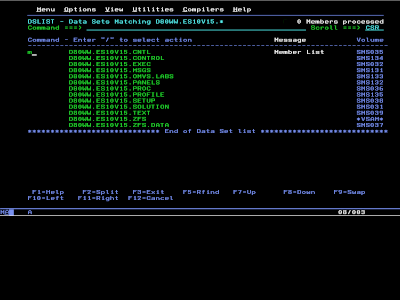Recipes for Using the Data Set List Utility (=3.4) as a Data Set Manager
Under Utility Selection Panel this tool listed as "Dslist"
The capabilities of Dslist to manipulate data sets overlap with other tools, like Library Utility in many ways.
The following recipes are based on the contents of the
Exercise 6 from the "Getting Started on Mainframe with z/OS"
Exercise Guide by IBM, they are easier to follow after doing the exercise from the guide,
I published them here as a "memory refresher".
Tip the F3 key can be used to return to a previous page.
------------------------------------------------------------------------ Displaying all the data sets that start with TSOCA03 as high level qualifier (aka Project), apart from the "catalog entry" ------------------------------------------------------------------------ ''' Tip: it's better to avoid possible manipulations of the catalog entry, as it is managed by the system administrator and the system itself. ''' * Enter =3.4 on the command line (from any panel) to open the Data Set List Utility * Press Enter * Tab to Dsname Level and enter TSOCA03.* * Press Enter
Note the Dsname serial field is obsolete and we won't touch it here.
----------------------------------------- Displaying attributes of a data set ----------------------------------------- * Output a list of data sets that start with a particular high level qualifier (Project) of interest * Tab to the data set of interest in that list * Enter S (Short information) or I (Information) * Press Enter -------------------------------------------------------------------------- Displaying a list of members in a partitioned data set (PDS or PDSE) -------------------------------------------------------------------------- * Output a list of data sets that start with a particular high level qualifier (Project) of interest * Tab to the PDS/E of interest * Enter M (Member list) * Press Enter
Tip
to see all the commands available for entering next to a data set, press the F1 key. You will see that you can rename, delete, copy, move data sets straight from this utility.
--------------------------------------------------- Deleting a member of a partitioned data set --------------------------------------------------- * Get a list of members displayed * Tab to the member that should be deleted * Enter D (Delete) * Press Enter * Press Enter (to confirm deletion) * Optionally, you can issue REFRESH on the command line to refresh the view ''' Note: Library Utility (=3.1) can also be used for this task. ''' ------------------------------------------------------------ Renaming member COB to CBL (of a partitioned data set) ------------------------------------------------------------ * Get a list of members displayed * Tab to the member COB * Enter R (Rename) * Press Enter * Tab to New Name (in the Member Rename pane) and enter CBL (Old Name should be pre-filled wth COB for you) * Press Enter * Optionally, you can issue REFRESH on the command line to refresh the view ''' Note: alternatively, Library Utility (=3.1) can be used for renaming members ''' --------------------------------------------------------------------------- Moving member CBL FROM TSOCA03.ES10.INDATA to TSOCA03.ES10.OUTDATA --------------------------------------------------------------------------- * Get a list of members displayed * Tab to the member CBL * Enter M (Move) * Press Enter * Under "To Library", enter the following fields: - Project: TSOCA03 - Group: ES10 - Type: OUTDATA * Press Enter * Optionally, you can issue REFRESH on the command line to refresh the view
By now, you probably won't have much trouble figuring out how to use the other options for data set basic manipulations in this utility, so I won't cover them here.

This page was last updated on April 05, 2025
